Over the last number of years, there has been a huge increase in the number of platforms and providers offering different online learning solutions. More and more people are taking premium online courses, low-cost or free tutorials, listening to educational podcasts, participating in distance learning, and even attending university virtually. However, while the interest in online learning was certainly on the rise, the events of the 2020s caused the uptake in online education to be accelerated in ways many would never have predicted.
The COVID-19 pandemic may have shut down the physical world with people’s movement restricted, lockdowns being enforced, businesses transitioning to remote working and hospitality and retail closing their doors for months on end. However, while the physical world turned into a ghost town, the online real came to life. As people had more free time than ever before, many took this opportunity to enroll in online courses and classes to further their education.
Schools, universities, and other educational institutes also had to turn to technology to keep their curriculums ticking along. While the uptake in online learning was already on the increase, there’s no denying the impact that the events have had on accelerating its acceptance in the current landscape.
Let’s take a look at just a few ways that the 2020s have impacted the world of online learning.
IMAGE: UNSPLASH
Adoption Of New Technologies
Schools, universities, and other educational institutes, were forced to adopt new technologies when students were no longer able to physically attend classes. Software such as Zoom is now a household name thanks to the pandemic. Although launched in 2013, not too many people knew what Zoom was until every online learner around the country, along with everyone else, was now using the software daily.
Educational institutes around the country developed systems that allowed their students to log in to classes remotely. They emailed homework assignments, handed grades out digitally and parent-teacher meetings were even conducted over video-chat. Technology played a huge role in how online learning changed due to the impacts of the pandemic and we can expect new technologies to continue to meet the needs of the ever-growing community of remote workers in countries all over the world.
More Online Education Opportunities Than Ever Before
As more people made the shift to online learning during the pandemic, more courses became available to meet the needs of the expanding market. Many existing providers took this opportunity to bolster their existing offerings to ensure they stood head and shoulders above newcomers to the market. New players also emerged, as well as schools, universities and educational centres all joining the market, offering a range of free and paid courses.
While competition in the online education space is greater than ever, for consumers, there is more choice than ever before. Whether you want to pay for a cheap course on one of the many online course websites or enroll in an online Bachelor’s Degree, there is no end to the avenues you can pursue with today’s vast online education options.
Increased Number Of People Enjoy The Benefits Of Online Learning
There are countless benefits to learning online and with online learning now available to more people than ever before, more people can finally start to enjoy this way of learning. Research has shown that students retain 25-60% more of the learning material when learning online than in a classroom setting. This has been thought to be due to the fact that students can learn at a pace that suits their learning style.
If they need to pause the lesson to go back and re-read something, they have that option. On the other hand, if they are accelerating at a particular topic, they can breeze through that section without hesitation. Having this control puts students in the driver’s seat, allowing them to take an approach to learning that suits them best.
The Potential For Digital Divide
While the overall feedback on online learning has been overwhelmingly positive, there is scope for somewhat of a digital divide as time goes on. As restrictions are becoming relaxed, some educational institutions are employing a hybrid model where half of the class will come to the physical classes half the week and the remaining students will attend on the other days of the week. With this approach, students have a chance to meet with their teachers and peers face-to-face to discuss different issues and to learn from one another.
Having some face-to-face time can be valuable, however, many online education providers are overcoming this issue by using software that allows students to communicate publicly, in break-out rooms, or privately with teachers or other students.
Online Learning Will Continue To Evolve Moving Forward
The events of the 2020’s certainly accelerated the growth of online learning and now with greater demand than ever before, providers are looking to the future with optimism. More online education providers are investing in new technologies, platforms, and software to improve the experience for their students moving forward. As time goes on, we can expect to see online learning continue to evolve and become more mainstream as providers fine-tune their offerings even more.
IMAGE: UNSPLASH
If you are interested in even more lifestyle-related articles and information from us here at Bit Rebels, then we have a lot to choose from.


COMMENTS